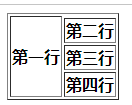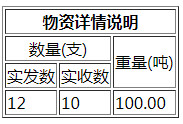先来回顾一下rowspan和colspan
<td>元素的colspan属性来实现单元格跨列操作,使用<td>元素的rowspan属性来实现单元格的跨行操作。
colspan属性规定单元格可横跨的列数,所有浏览器都支持colspan属性。其取值为number,
如下图所示:
例如:
1
2
3
4
5
6
7
8
9<table border="1"> <tr> <th>星期一</th> <th>星期二</th> </tr> <tr> <td colspan="2">星期天</td> </tr> </table>
实现结果如下图所示:
rowspan属性规定单元格可横跨的列数,所有浏览器都支持rowspan属性。其取值为number,如下图所示:
例如:
1
2
3
4
5
6
7
8
9<table border="1"> <tr> <td rowspan="2">星期一</td> <td>星期二</td> </tr> <tr> <td>星期三</td> </tr> </table>
实现结果如下图所示:
总结colspan和rowspan的使用如下:
1
2
3
4
5
6
7
8
9
10
11
12
13
14
15
16
17
18<table border="1"> <tr> <th colspan="3">物资详情说明</th> </tr> <tr> <td colspan="2" align="center">数量(支)</td> <td rowspan="2">重量(吨)</td> </tr> <tr> <td>实发数</td> <td>实收数</td> </tr> <tr> <td>12</td> <td>10</td> <td>100.00</td> </tr> </table>
实现结果如下图所示:
下面进入正题:
假设没有rowspan的时候,首行下面有三行,如果执行了rowspan=4(rowspan=1,表示占用一行,其本身就是占用一行,所以如果要额外占用其他的三行,那么rowspasn=1+3),这个时候会占用下面三行的,看起来的效果就是合并了其余三行(使用rowspan,那么它本身和它即将要合并的行必须在不同的行,并且处于相同的列)
1
2
3
4
5
6
7
8
9
10
11
12
13
14
15
16
17
18
19<html> <body> <table border="1"> <tr> <th>第一行</th> </tr> <tr> <th>第二行</th> </tr> <tr> <th>第三行</th> </tr> <tr> <th>第四行</th> </tr> </table> </body> </html>
效果图:

如果合并三面的三行:
1
2
3
4
5
6
7
8
9
10
11
12
13
14
15
16
17
18
19<html> <body> <table border="1"> <tr> <th rowspan="4">第一行</th>//合并三面的三行,会把下面三行的位置占据,下面的三行将会被挤到右边去 </tr> <tr> <th>第二行</th> </tr> <tr> <th>第三行</th> </tr> <tr> <th>第四行</th> </tr> </table> </body> </html>
效果图:

碰到项目中的一个问题:
有个树结构的数据,它有多个顶级节点(AuditorInfoObject),每个顶级可能有子节点(TaskObject),子节点可能还有自己的子节点(BaseObject),如何形成合并行的table:
解决步骤:
1.计算最顶级节点占用的行数(即rowspan)
1
2
3
4
5
6
7
8
9
10
11
12
13
14
15
16
17
18private Map<Integer,Integer> countMap = new HashMap<>();//key为顶级节点的索引值,value为rowspan的数量 if(this.auditorList != null) { //计算页面合并行的总个数 for(int i = 0;i < this.auditorList.size();i++) { int total = 1;//每个顶级节点自己原本就占有一行 List<TaskObject> childrens = this.auditorList.get(i).getChildren(); if(childrens != null && childrens.size() > 0) { for(TaskObject child:childrens) { total++;//每个子节点占一行 List<BaseObject<?>> processElenmentList = child.getProcessElenmentList(); if(processElenmentList != null && processElenmentList.size() > 0) { total += processElenmentList.size();//每个子节点的子节点又占一行 } } } countMap.put(i, total); } }
2.在页面写好三层循环结构:
jsp代码:
1
2
3
4
5
6
7
8
9
10
11
12
13
14
15
16
17
18
19
20
21
22
23
24
25
26
27
28
29
30
31
32
33
34
35
36
37
38
39<table class="table" style="width:100%;border:0px;" id="shcx_table"> <tbody> <tr> <th height="18px;" style="text-align:center">顶级节点</th> <th style="text-align:center;" id="myStep">一级节点</th> <th style="text-align:center;" id="myName">二级节点</th> </tr> <s:iterator value="auditorList" var="obj" status="l"> <tbody title="<s:property value="#obj.processName" />"> <tr><!-- 顶级节点 --> <th rowspan="<s:property value="countMap.get(#l.index)"/>" style="text-align:center; width:80px;"> <s:property value="#obj.processName"/> </th> </tr> <s:iterator value="#obj.children" var="c"><!-- 一级节点 --> <s:if test="#c.processElenmentList != null && #c.processElenmentList.size() > 0"> <tr> <th rowspan="<s:property value="#c.processElenmentList.size()+1"/>" style="text-align:left; width:80px;"> <s:property value="#c.stepName"/> </th> </tr> <s:iterator value="#c.processElenmentList" var="r"><!-- 二级节点 --> <tr> <th style="text-align:left; font-weight:normal;width:400px"><s:property value="#r.elementName"/></th> </tr> </s:iterator> </s:if> <s:else> <tr><!-- 一级节点没有子节点走这里 --> <th style="text-align:left; font-weight:normal;width:10px"><s:property value="#c.stepName"/></th> <th style="text-align:left; font-weight:normal;width:400px">无子节点</th> </tr> </s:else> </s:iterator> </tbody> </s:iterator> </tbody> </table>
显示效果:

红色箭头表示父节点方向,对于这种结构树,
可以这么做:
(1)可以先不考虑合并行,把每个tr从父节点到子节点都一一用td列出来
即:每一行tr都是从顶级节点到最后一个节点都一一用td装入进来
(2)在顶级节点使用rowspan,这个时候会发现:顶级节点的rowspan=1(root本身占1行)+该节点拥有的一级子节点(root.getChildren().size())+每一个子节点拥有的子节点树(child.getProcessElenmentList().size())
(3)在使用的rowspan之后,把被挤到右侧的节点的顶级节点删除掉(被合并的行不再需要root节点,只有第一行需要,其他的行和第一行公用root节点)
(4)因为一级节点也有子节点,此时再合并一级节点,步骤同顶级节点...
参考:https://blog.csdn.net/u012724595/article/details/79401401
转载于:https://my.oschina.net/u/2331760/blog/3072727
最后
以上就是温婉马里奥最近收集整理的关于strus2在jsp页面利用利用s:iterator三层循环合并多行的全部内容,更多相关strus2在jsp页面利用利用s内容请搜索靠谱客的其他文章。








![JSP 2.0: The New Deal, Part 1 [转载]](/uploads/reation/bcimg1.png)




发表评论 取消回复